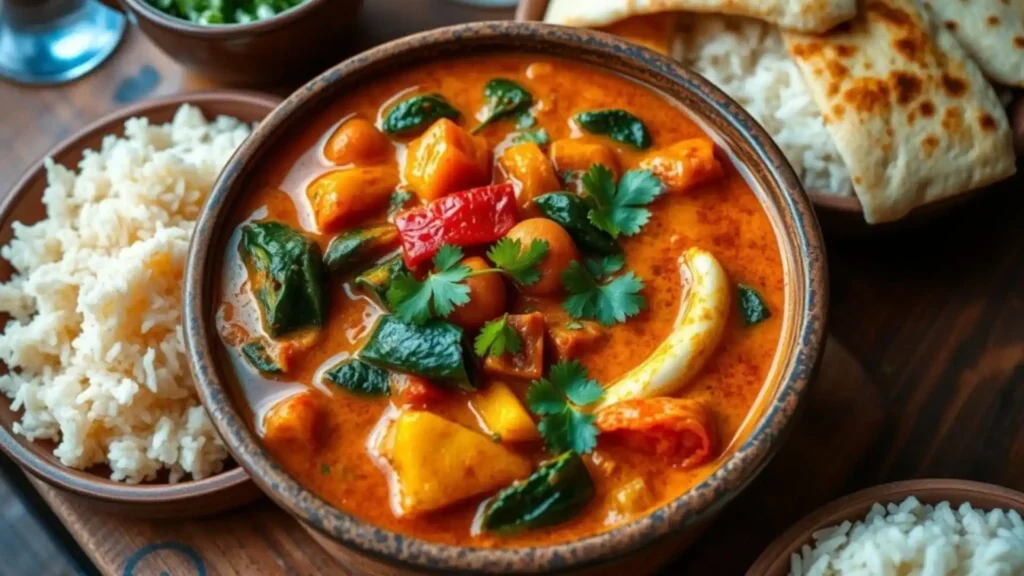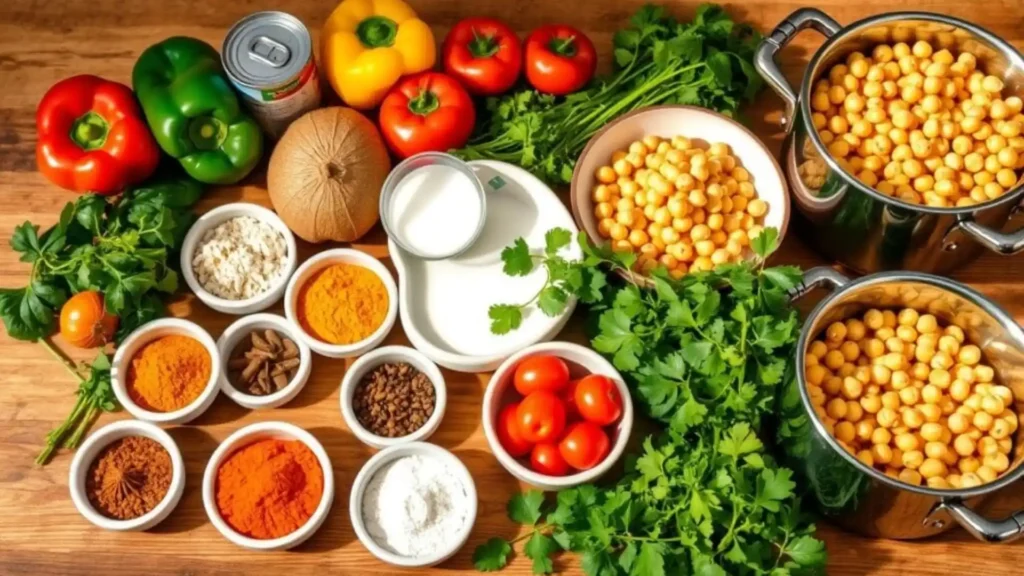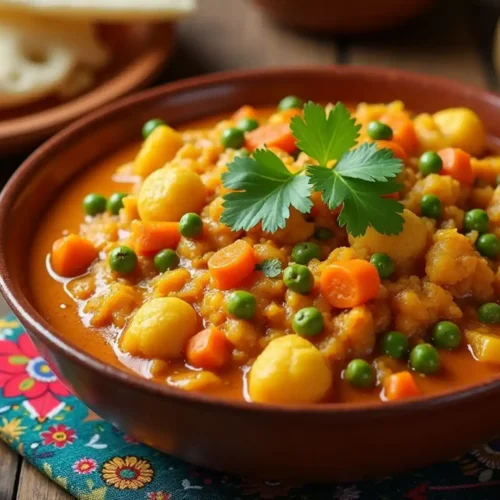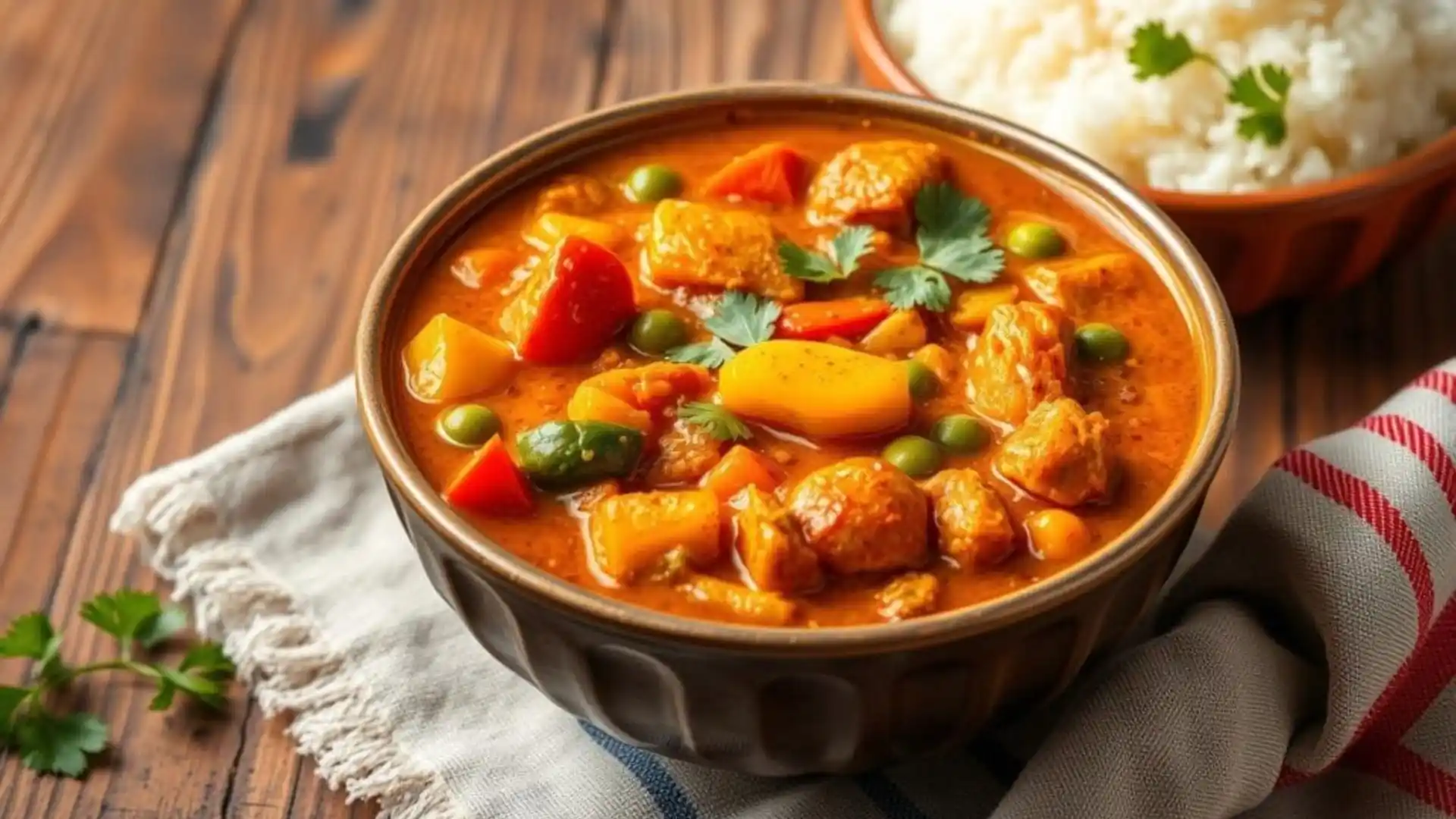As the day ends and hunger grows, a comforting meal is just what you need. But, with little time and money, eating out at an Indian place seems far away. What if you could make a delicious Indian vegetarian curry at home in under 30 minutes? And do it for much less than eating out?
Growing up, our home was filled with the smells of spices and onions. It meant dinner was coming, and we all loved it. The creamy curry with basmati rice or naan was a sensory treat. Now, I’m sharing a quick recipe that brings back those flavors, without the long prep time.
Key Takeaways
- Prepare a delicious, authentic-tasting Indian vegetarian curry at home in under 30 minutes
- Enjoy the rich, creamy flavors of this curry dish without breaking the bank
- Use a mix of fresh and frozen ingredients for convenience and cost-effectiveness
- Savor the aroma of freshly toasted spices and simmering vegetables in your own kitchen
- Easily customize the recipe to suit your dietary preferences and taste buds
The Perfect Quick-Fix Vegetarian Curry Recipe
Are you looking for a tasty, meatless curry that’s quick to make? This plant-based curry recipe is your answer. It’s a flavorful, veggie-packed meal ready in under 30 minutes.
What Makes This Recipe Special
This recipe is special because it’s simple yet full of flavor. It uses spices like curry powder and garam masala for an authentic Indian taste. When time is tight on weekday evenings, this uncomplicated recipe proves invaluable.
Key Benefits of Homemade Curry
Making your own curry at home has many benefits. You save money, can adjust the flavors, and know what’s in your food. Homemade curries are also healthier, with fewer preservatives and more nutrients.
Time-Saving Advantages
This recipe is made for convenience. It uses frozen veggies, canned tomatoes, and spice blends to save time. You can make a delicious plant-based curry in minutes. Plus, it’s all cooked in one pot, making cleanup easy.

Essential Ingredients for Your Curry Success
To make a tasty vegan curry entrée or vegetable curry meal at home, start with these key ingredients:
- Oil (olive or coconut) for sautéing
- Aromatic vegetables like onions, garlic, and ginger
- Canned diced tomatoes or fresh tomatoes
- Almond butter or cashew butter for creaminess
- Curry powder and garam masala spice blends
- Red pepper flakes or cayenne for heat
- Frozen mixed vegetables or protein-rich chickpeas
- Coconut milk or Greek yogurt for a creamy texture
These ingredients help create a balanced taste and texture in your homemade vegan curry entrée or vegetable curry meal. You can adjust amounts or swap out ingredients based on what you like or have on hand.
| Ingredient | Purpose |
|---|---|
| Oil | Sautéing aromatics and developing flavor |
| Onions, Garlic, Ginger | Providing the foundation of aromatic flavors |
| Tomatoes | Adding acidity and body to the curry sauce |
| Nut Butter | Lending creaminess and richness to the dish |
| Spice Blends | Imparting the signature Indian curry flavors |
| Vegetables/Chickpeas | Providing texture, nutrients, and substance |
| Coconut Milk/Yogurt | Enhancing the creamy, indulgent mouthfeel |
With these ingredients, you’re ready to make a delicious vegan curry entrée or vegetable curry meal that will wow your taste buds.

“The key to a great curry is finding the perfect balance of spices and aromatics to create a complex, satisfying flavor profile.”
The Secret Behind This 30-Minute Curry
Want a quick and tasty vegetarian curry ready in 30 minutes? The trick is using an Indian mirepoix, the right spice blend, and some smart ingredient hacks. You’ll love this meat-free or dairy-free curry that’s both healthy and delicious.
The Power of Indian Mirepoix
The base of this curry is the Indian mirepoix – onions, garlic, and ginger. Cooking them in coconut or olive oil makes them sweeter and releases their scent. This creates a fragrant start for the dish.
Choosing the Right Spice Blend
A good curry powder is essential for flavor. It usually has cumin, coriander, turmeric, and garam masala. You can adjust the amount to your taste and how spicy you like it.
Time-Saving Ingredient Tips
- Use frozen veggies for quick prep – they’re nutritious and save time.
- Choose canned diced tomatoes to skip peeling and chopping fresh ones.
- Find pre-minced garlic and ginger in the produce section for easier prep.
- Creamy almond butter adds a rich flavor and creaminess to the curry.
With these smart choices and tips, you can make a flavorful, quick curry in minutes. It’s great for busy weeknights.

30 Minute Indian Vegetarian Curry
Equipment
- Large skillet or pot
- Can opener
- Measuring spoons
- Measuring cups
- Cutting board
- Sharp knife
- Stirring spoon
Ingredients
- 1 tablespoon vegetable oil
- 1 onion finely chopped
- 3 cloves garlic minced
- 1 tablespoon ginger grated
- 1 tablespoon curry powder
- 1 teaspoon ground cumin
- 1 teaspoon ground coriander
- 1/2 teaspoon turmeric
- 1/4 teaspoon cayenne pepper optional
- 1 can 14 oz diced tomatoes
- 1 can 14 oz chickpeas, drained and rinsed
- 1 can 14 oz coconut milk
- 2 cups mixed vegetables e.g., cauliflower, peas, carrots, potatoes
- Salt and pepper to taste
- Fresh cilantro for garnish
Instructions
- Heat the oil in a large skillet or pot over medium heat. Add the onion and cook until softened, about 5 minutes.
- Add the garlic, ginger, curry powder, cumin, coriander, turmeric, and cayenne (if using). Cook for 1-2 minutes until fragrant.
- Stir in the diced tomatoes, chickpeas, and coconut milk. Bring the mixture to a simmer.
- Add the mixed vegetables and cook until they are tender, about 10-15 minutes. If the curry becomes too thick, add a little water or vegetable broth.
- Season with salt and pepper to taste.
- Serve the curry hot over rice or with naan bread. Garnish with fresh cilantro.
Notes
- Customize the vegetables based on your preferences or what you have on hand.
- For a creamier curry, use full-fat coconut milk. For a lighter version, use low-fat coconut milk or replace some with vegetable broth.
- Adjust the spice level by adding more or less cayenne pepper.
- Leftovers can be stored in an airtight container in the refrigerator for up to 4 days or frozen for up to 3 months.
- To make this recipe vegan, ensure the vegetable oil is vegan-friendly.
- For a complete meal, serve with rice or naan bread, and a side salad or raita (Indian yogurt sauce).
Kitchen Tools and Equipment Needed
To make your curry sans meat or herb-infused vegetarian curry, you’ll need some basic tools. Start with a large pot or Dutch oven for simmering. A wooden spoon is key for stirring and blending. Make sure you have measuring spoons and cups for accurate spice portions.
A food processor is great for mincing garlic and ginger quickly. A sturdy can opener is essential for canned ingredients like coconut milk. And, a sharp knife is needed for chopping fresh veggies that add color and texture.
Having all your tools ready before cooking makes the process smoother. This way, you can focus on making a tasty, homemade curry in under 30 minutes. With the right tools, you’ll master quick and flavorful vegetarian curries.
| Essential Kitchen Tools | Additional Helpful Items |
|---|---|
|
|
With the right tools and equipment, making delicious curry sans meat or herb-infused vegetarian curry is easy and efficient.
Step-by-Step Cooking Instructions
Making a tasty vegetarian curry at home is simple. Just follow these easy steps to make a dish that’s ready in under 30 minutes.
Preparing the Base
Begin by sautéing diced onion, minced garlic, and grated ginger in a large skillet or Dutch oven with a bit of vegetable oil. Cook until the onions are clear and the aromas are strong about 5 minutes.
Adding Vegetables and Spices
Then, add the spices to the pan – like Madras curry powder, ground cumin, turmeric, and a pinch of cayenne pepper. Stir well and let the spices bloom for 1-2 minutes. Next, add diced tomatoes, almond butter, and your favorite vegetables like carrots, potatoes, broccoli, bell pepper, and green beans. Simmer for 15-20 minutes, until the veggies are tender.
Final Touches and Garnishing
To complete the vegetarian curry recipe, stir in a can of full-fat coconut milk or a dollop of plain yogurt. Season with soy sauce or fish sauce, and a bit of sugar to balance the flavors. Finally, sprinkle in some garam masala and garnish with fresh cilantro. Serve the delicious meatless curry over steamed rice or with warm naan bread.
By following these simple steps, you’ll have a satisfying, nutrient-rich vegetarian curry recipe ready in no time. Feel free to adjust the spices and vegetables to your liking for a meal that’s all yours.
Customizing Your Vegetarian Curry
Plant-based curry dishes are great because you can make them your own. You can add more spice or a sweeter taste. It’s all about what you like in your veggie curry.
Want it spicier? Add more curry powder or cayenne pepper. For a milder taste, use less spice or try maple syrup or coconut milk.
- Try different veggies like sweet potatoes, bell peppers, or spinach for more flavor and color.
- Add tofu, tempeh, or chickpeas for extra protein and to make it more filling.
- Top it off with fresh cilantro or a squeeze of lime juice for a burst of flavor.
Customizing your veggie curry is all about having fun and listening to your taste. Make it your own and enjoy the delicious outcome!
Serving Suggestions and Pairings
Make your homemade vegan curry entrée or vegetable curry meal even better. Pair it with the right sides. From fluffy basmati rice to classic Indian flatbreads, these ideas will enhance your curry experience.
Rice and Bread Options
- Basmati Rice: Fragrant and light, basmati rice is the traditional choice to serve alongside Indian curries.
- Quinoa: For a nutritious, gluten-free option, try pairing your curry with fluffy quinoa.
- Cauliflower Rice: A low-carb alternative, cauliflower rice provides a neutral base to soak up the flavorful curry.
- Naan Bread: This soft, pillowy flatbread is an essential companion to curries, perfect for dipping and scooping.
- Roti: Thin and crisp, roti is another classic Indian bread that complements curries beautifully.
- Flatbreads: Experiment with other flatbreads like paratha, chapati, or pita for variety.
Complementary Side Dishes
To create a well-rounded meal, consider adding these delicious side dishes to your curry spread:
| Side Dish | Description |
|---|---|
| Raita | A cooling yogurt-based condiment with cucumber, mint, and spices. |
| Pickled Vegetables | Crunchy, tangy, and flavorful pickles like mango, lime, or mixed veggies. |
| Fresh Salad | A vibrant salad like kachumber (tomato, onion, and cucumber) or sprouts salad. |
Garnish your curry with chopped nuts, sliced red onions, or lemon wedges for added texture and flavor. With these serving suggestions, your homemade vegan curry entrée or vegetable curry meal is sure to impress.
Storage and Meal Prep Tips
Preparing a delicious meat-free curry is a joy. But what about leftovers? Don’t worry, we’ve got tips to keep your dairy-free curry fresh and tasty for days.
To store leftovers, put them in an airtight container and refrigerate. Your curry can stay good for up to 4 days. Just reheat it on the stovetop until it’s hot.
For meal prep, portion out your curry into containers. Refrigerate or freeze them for later. Frozen curry lasts up to 2 months. Thaw it in the fridge before reheating.
Storing or prepping ahead? A few tips can keep your curry’s quality and flavor. With planning, enjoy homemade curry anytime, without losing taste or texture.
So, enjoy your meat-free curry’s aroma and creaminess. You can have it again and again with these easy storage and meal prep tips.
Health Benefits and Nutritional Information
This curry sans meat recipe is not just tasty but also very nutritious. It’s made with fresh veggies, chickpeas, and spices. This herb-infused vegetarian curry is full of important nutrients.
Protein Content
This curry has 11 grams of protein in each serving. Chickpeas, the main protein source, make it great for vegetarians. It’s also good for those who want more protein in their diet.
Vitamin and Mineral Profile
This curry is packed with vitamins and minerals. It has 240mg of calcium, 510mg of potassium, and 157mg of phosphorus. These help keep your bones strong and support your overall health. It also has 3mg of iron, which fights anemia.
Dietary Considerations
The curry sans meat recipe is gluten-free and can be vegan with coconut milk. It’s also cholesterol-free, making it good for your heart. With only 230 calories and no sugar, it’s perfect for weight management or diabetes control.
| Nutrient | Amount per Serving |
|---|---|
| Calories | 230 |
| Total Fat | 14g |
| Saturated Fat | 6g |
| Cholesterol | 0mg |
| Sodium | 286mg |
| Total Carbohydrates | 19g |
| Dietary Fiber | 5g |
| Protein | 11g |
| Calcium | 240mg |
| Potassium | 510mg |
| Iron | 3mg |
This herb-infused vegetarian curry is a great choice for a healthy meal. It’s full of nutrients and tastes amazing.
Troubleshooting Common Curry Issues
Making the perfect vegetarian curry can be tricky, but we’ve got you covered! You might face issues like a thin sauce, bland flavor, or overcooked veggies. But don’t worry, these easy tips will help you fix these problems and make a delicious curry.
Thin Sauce
Got a thin curry sauce? No worries. Just let it simmer a bit longer. Let everything simmer together, allowing both taste development and natural thickening to occur. You can also add a cornstarch slurry. Mix a tablespoon of cornstarch with a couple tablespoons of water, then stir it into the curry.
Bland Flavor
Want more zing in your curry? Add more spices like garam masala, cumin, or chili powder. A pinch of salt can also enhance the flavors. Taste and adjust the seasonings until it’s perfect.
Overcooked Veggies
Don’t like mushy veggies in your curry? Add delicate ingredients like spinach or peas towards the end. This way, they stay fresh and colorful.
Spice It Up (or Cool It Down)
Want a spicier curry? Add more chili powder or finely chopped chilies. If it’s too hot, cool it down with coconut milk or yogurt.
With these tips, you’ll soon be making delicious vegetarian curries. Enjoy the fruits of your labor!
This easy Indian vegetarian curry recipe is perfect for busy weeknights. It combines the rich flavors of Indian cuisine with pantry and freezer staples. This way, you can enjoy a restaurant-quality curry at home, saving money and making it your own.
The entire process requires just twenty minutes – a quick ten-minute prep followed by ten minutes of cooking time. This recipe makes 4 servings, great for meal-prepping or small families. The chickpea mixture can stay fresh in the fridge for up to 4 days. This makes it easy to have a quick, nutritious meal any day of the week.
If you love Indian cuisine or just want a tasty, healthy homemade curry, this recipe is for you. Learning to make this dish means you can enjoy India’s bold flavors anytime. It’s a quick and delicious meal option for your family.
Frequently Asked Questions (FAQ)
What makes this vegetarian curry recipe special?
This easy vegetarian curry recipe is special because it’s simple, flavorful, and affordable. It uses fresh veggies, real spices, and a creamy sauce from coconut milk or yogurt. It’s ready in under 30 minutes.
What are the key benefits of making this curry at home?
Making curry at home saves money, lets you choose what goes in, and uses healthier ingredients. You can also adjust the spice and flavor to your liking.
What are the time-saving advantages of this recipe?
This recipe is quick because it uses frozen veggies, canned tomatoes, and pre-made spice blends. It’s made in one pot, making cleanup easy.
What are the essential ingredients in this vegetarian curry?
The main ingredients are oil, onion, garlic, ginger, tomatoes, almond butter, curry powder, garam masala, red pepper flakes, frozen mixed veggies, chickpeas, and coconut milk or yogurt.
What is the importance of the Indian mirepoix in this recipe?
The Indian mirepoix of onion, garlic, and ginger is key for flavor. Cooking them well is important for a rich taste.
How do I choose the right curry powder for this recipe?
Choosing the right curry powder is crucial. Use the right amount for your taste. Try different blends to find your favorite flavor.
What kitchen tools and equipment are needed for this recipe?
You’ll need a big pot or Dutch oven, a spoon, measuring tools, a can opener, and a knife. A food processor helps with mincing garlic and ginger.
How can I customize this vegetarian curry recipe?
Customize by changing spice levels, adding different veggies, or tofu. You can also add a bit of sweetness with maple syrup.
What are some recommended serving suggestions and pairings for this curry?
Serve with basmati rice, quinoa, or cauliflower rice. Try it with naan, roti, or flatbread. Add raita, pickled veggies, or a salad for extra flavor.
How should I store and reheat any leftovers?
Store any remaining portions in an airtight vessel, where they’ll stay fresh in your refrigerator for about four days. Reheat on the stovetop. For freezing, portion and store for up to 2 months.
What are the health benefits and nutritional information of this vegetarian curry?
This curry is packed with protein, fiber, and healthy fats. It’s full of vitamins and minerals. It’s gluten-free and can be made vegan.
How can I troubleshoot any issues with the curry?
If it’s too thin, simmer longer or add a cornstarch mix. For bland flavor, add more spices or salt. To fix overcooked veggies, add them later. For more heat, add chili powder or fresh chilies. Balance with coconut milk or yogurt.

